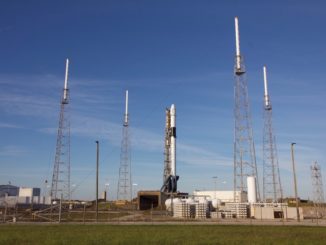Science
SpaceX Set to Launch Falcon 9 Rocket on Historic 31st Flight

SpaceX is preparing to set a new milestone in space exploration on October 22, 2024, when it launches its Falcon 9 rocket for a record-breaking 31st time. The mission, designated as Starlink 10-17, will take place from Cape Canaveral Space Force Station in Florida, with liftoff scheduled for 11:49 a.m. EDT (15:49 UTC).
The Falcon 9 booster, identified as B1067, will be the centerpiece of this mission, further solidifying its status as SpaceX’s most frequently flown rocket. This particular booster last took to the skies on August 28, 2025, during the Starlink 10-11 mission.
Weather conditions are expected to be favorable for the launch, with the 45th Weather Squadron forecasting over a 95 percent chance of good weather during the launch window. Meteorologists have indicated that no adverse weather phenomena are anticipated to disrupt the flight.
Details of the Launch and Recovery
Approximately eight and a half minutes after liftoff, SpaceX aims to successfully land booster B1067 on its drone ship, A Shortfall of Gravitas. This landing will mark the 129th recovery on this vessel and the 520th overall landing for SpaceX.
This launch underscores SpaceX’s ongoing efforts to certify its Falcon boosters for up to 40 launches and landings. In recent months, the majority of these missions have involved deploying Starlink satellites, with the last seven flights of B1067 dedicated to this satellite constellation. The Starlink 10-17 mission will introduce an additional 28 satellites into low Earth orbit, expanding the company’s global internet coverage.
SpaceX has also achieved impressive turnaround times for its launch pad operations. The previous mission from Space Launch Complex 40 set a new record for rapid pad turnaround. According to Kiko Dontchev, SpaceX’s Vice President of Launch, the last launch, Starlink 10-52, established two significant milestones: the fastest launch-to-launch from the same American launch pad at just 55 hours, 29 minutes, and 9 seconds, and the quickest transporter erector roll into the hangar for booster integration at 12 hours, 5 minutes, and 20 seconds.
Looking Ahead
As SpaceX continues to push the boundaries of reusable rocket technology, the upcoming launch will not only mark a record for Falcon 9 but also set the stage for potential future milestones. Dontchev expressed confidence in the Falcon team’s ability to achieve a sub-48-hour launch turnaround from Pad 40 this year, aiming to challenge the historical record set by the Soviet Union in 1962 with their Vostok missions.
With each successive launch, SpaceX demonstrates its commitment to advancing space travel and satellite deployment, paving the way for significant innovations in the aerospace industry. The Starlink 10-17 mission represents yet another step toward enhancing global connectivity through advanced satellite technology.
-

 Business5 days ago
Business5 days agoUK to Finalize Stablecoin Regulations by 2026, Boosting Crypto Sector
-

 Business5 days ago
Business5 days agoU.S. and U.K. Target Cybercriminal Networks, Seize $15 Billion
-

 Lifestyle5 days ago
Lifestyle5 days agoKISS OF LIFE’s Natty Dazzles in Micro-Shorts at Seoul Event
-

 World5 days ago
World5 days agoMilitary Artillery Plan Sparks Safety Concerns Along California Highway
-

 Sports5 days ago
Sports5 days agoDomenico Doran’s Stellar Performance Leads Bishop Amat to Victory
-

 World5 days ago
World5 days agoTrump Signals Reluctance to Sell Tomahawk Missiles to Ukraine
-

 Business5 days ago
Business5 days agoCalifornia to Eliminate All Plastic Bags from Stores by 2026
-

 Entertainment5 days ago
Entertainment5 days agoLouisiana Senate Raises Concerns Over Medicaid Cuts Amid New Bill
-

 Entertainment5 days ago
Entertainment5 days agoUtah Communities Rally as Government Shutdown Strains Resources
-

 Science2 days ago
Science2 days agoAncient Dinosaur Discovery in Argentina Reveals Evolutionary Insights
-

 Sports5 days ago
Sports5 days agoTrade Low, Trade High: Key NHL Players to Consider Now
-

 Health2 days ago
Health2 days agoUncovering the Hidden Link Between Knee Pain and Hip Issues









